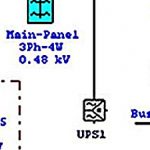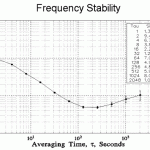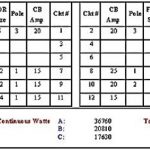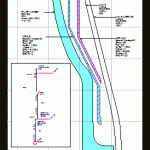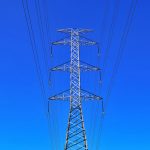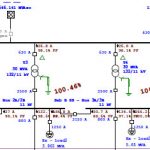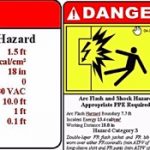Since many years, i.e. from the start of high voltage power station development, the grounding grid analysis began with the theoretical or experimental analysis based on which different authors rendered rough expressions. These expressions were carried out on a single horizontal or vertical grounding rod. With the knowledge obtained from the behaviour of single vertical or horizontal grounding rod, different authors suggested additional approximate analytical representations for the grounding grids. Proposed analytical expressions had different restrains regarding dimensions and geometry of the grounding grid. It became clear that all these empirical formula have considerable drawbacks when applied to the complex geometry grounding grid.
Why is Grounding Grid Design Analysis and Study Necessary?
The aim of a ground grid design is to limit electric shock related accidents. The circumstances leading to the shock accidents are:
- High fault current to ground.
- Large soil resistivity.
- Existence of a person connecting 2 points of large potential difference.
- Lack of adequate contact resistance or other series resistance to regulate current through the body to a safe value.
- Time duration of the fault and body current for an adequate time to cause harm at the given current intensity.
The grounding system can be designed such that the step and touch voltages are kept within the calculated safe limits.
The benefits of this study include:
- Design time savings
- Material cost savings by determining the minimum size of conductors and number of ground rods to keep the potential values below the IEEE limits.
What is Done During Grounding Grid Analysis and Study?
The analysis contains of these steps:
- Inspection of soil characteristics.
- Calculation of peak ground current.
- Initial design of the ground system.
- Determination of resistance of the ground system.
- Determination of step voltages at the margin.
- Determination of internal step and touch voltages.
- Fine-tuning of preliminary design.
Due to the fact that grounding grid is buried in the earth, its mathematical treatment occupied prominent position from the very beginning of the grounding grid analysis. Hence, various soil interpretation techniques have been surveyed as well. They are basically concerned with the problems associated with a boundary between soil and air. While speaking with techniques adapt for the transient grounding grid behaviour, one needs to distinguish three very different approaches:
- Circuit approach: It is said to be fast and relatively easy to understand, but at the same time least accurate.
- Electromagnetic approach: Main difficulty in applying electromagnetic approach stems from the complex mathematical apparatus, which transforms Maxwell equations in system of algebraic equations, and its associated numerical implementation. Here one can distinguish between finite element approach, boundary element approach and approach according to the method of moments.
- Hybrid approach: It is a synergy between the two above mentioned approaches and can vary in complexity as well as in accuracy.
From the point of view of problem formulation, methods could be regarded as a
- Differential problem formulation
- Integral method
- Integro-differential method
How is Grounding Grid Analysis Done?
Following steps are performed during the analysis procedure:
- Soil resistivity: The potential rise of a grounding system during ground fault conditions is directly proportional to the resistance of the grounding system. Resistance of the grounding system is also important for the satisfactory operation of over current devices. Hence, it is essential to predict the resistance of the grounding system before its actual installation
- Effect of voltage gradient: The ground resistance is not affected by the voltage gradient unless it is greater than 103 Volts/cm. When this value is exceeded, arcs will start at the electrode surface and progress into ground so as to increase the effective size of the electrode which the soil can withstand.
- Effect of moisture: The resistivity of the soil rises abruptly when the moisture content falls below 22% by weight. It is therefore necessary that the electrode system should be buried deep enough to ensure contact with permanently moist soil. Where this is not possible, greater dependence will usually be placed on a well distributed system of vertical rods bonded to the ground grid and reaching deep layers.
- Effect of temperature: Resistivity of soil rises abruptly when the temperature falls below 32°F. The ground grid electrode system should extend below the frost line wherever feasible to minimize seasonal variation of the grounding system resistance. Further, the overall resistance of the ground grid varies with season due to the summer and winter temperature variations.
- Determination of maximum ground fault current: The following steps are involved in determining the maximum grid current Ig for use in substation grounding calculations:
- Assess the type and location of those ground faults that are likely to produce the greatest flow of current between the grounding grid and surrounding earth producing the greatest rise in grid potential with respect to remote earth.
- Calculate the fault current division factor Sf for each of the faults selected and establish the corresponding values of symmetrical grid current Ig.
- For each fault, based on its duration time, determine the value of decrement factor to allow for the effects of asymmetry of the fault current wave.
- Conductor size: The conductor should have sufficient conductivity so that it will not contribute substantially to dangerous local voltage differences. Usually the conductor size is selected based on standard annealed soft copper wire with brazed joints on ambient temperature (Ta) of 40°C and maximum temperature (Tm) of 450°C. Knowing the magnitude of the current and time duration the required conductor area can be evaluated.
- Ground grid potentials: The step voltage, the touch voltage and the ground grid potential rise are evaluated for each substation grid. Equations are used to calculate the step, touch and mesh voltages which include geometric factors Km (for touch and mesh voltage) and Ks (for step voltage). A grid irregularity factor Ki is also incorporated into the step.
- Design of ground grid system: The design of a grid will start with an inspection of the layout plan for equipment and structures. A continuous cable should surround the grid perimeter to enclose the area as to avoid current concentration. Within the grid, the conductors are laid in parallel lines at uniform spacing. The conductors should be located along rows of structures or equipment.
- Calculation of ground grid resistance: The ground grid resistance can be calculated by use of the following equation of the ground grid equivalent to a flat circular plate.
- Refinement of ground grid design: Throughout the calculations a reduced value of the coefficient Ki is used on the premise that the user will reinforce external comers of the grid with additional conductors. A higher current density occurs in the perimeter conductors and at corners leading to higher potential gradients. By using a closer grid spacing at corners, potential gradients are lowered and using a closer grid spacing at corners can substantiate a reduction in the value of Ki.
Computer Aided Analysis
There are several programs available to perform the grounding grid analysis or design. These programs analyse the substation grounding grid design, given the total electric current injected into the grid. The grounding grid can be single or multiple structures. A multiple grounding structure can be two or more embedded system of conductors, which are not electrically connected.
The required data for the program for the analysis include the following:
- The soil resistivity at the substation location.
- Geometry of the grounding system.
- Specification of the body current calculations.
The output of the program contains the following:
- Allowable step voltage.
- Allowable touch voltage.
- Calculated step voltage.
- Calculated touch voltage.
- Ground grid resistance.
- Ground grid or mesh voltage rise.
- Body currents.
- Potential profiles.

